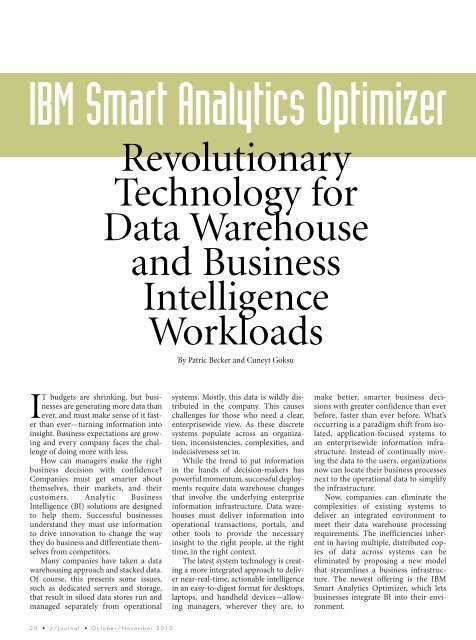z/VSE: 45 Years of Progress - z/VM - IBM
z/VSE: 45 Years of Progress - z/VM - IBM
z/VSE: 45 Years of Progress - z/VM - IBM
You also want an ePaper? Increase the reach of your titles
YUMPU automatically turns print PDFs into web optimized ePapers that Google loves.
<strong>IBM</strong> Smart Analytics Optimizer<br />
Revolutionary<br />
Technology for<br />
Data Warehouse<br />
and Business<br />
Intelligence<br />
Workloads<br />
By Patric Becker and Cuneyt Goksu<br />
IT budgets are shrinking, but businesses<br />
are generating more data than<br />
ever, and must make sense <strong>of</strong> it faster<br />
than ever—turning information into<br />
insight. Business expectations are growing<br />
and every company faces the challenge<br />
<strong>of</strong> doing more with less.<br />
How can managers make the right<br />
business decision with confidence?<br />
Companies must get smarter about<br />
themselves, their markets, and their<br />
customers. Analytic Business<br />
Intelligence (BI) solutions are designed<br />
to help them. Successful businesses<br />
understand they must use information<br />
to drive innovation to change the way<br />
they do business and differentiate themselves<br />
from competitors.<br />
Many companies have taken a data<br />
warehousing approach and stacked data.<br />
Of course, this presents some issues,<br />
such as dedicated servers and storage,<br />
that result in siloed data stores run and<br />
managed separately from operational<br />
systems. Mostly, this data is wildly distributed<br />
in the company. This causes<br />
challenges for those who need a clear,<br />
enterprisewide view. As these discrete<br />
systems populate across an organization,<br />
inconsistencies, complexities, and<br />
indecisiveness set in.<br />
While the trend to put information<br />
in the hands <strong>of</strong> decision-makers has<br />
powerful momentum, successful deployments<br />
require data warehouse changes<br />
that involve the underlying enterprise<br />
information infrastructure. Data warehouses<br />
must deliver information into<br />
operational transactions, portals, and<br />
other tools to provide the necessary<br />
insight to the right people, at the right<br />
time, in the right context.<br />
The latest system technology is creating<br />
a more integrated approach to deliver<br />
near-real-time, actionable intelligence<br />
in an easy-to-digest format for desktops,<br />
laptops, and handheld devices—allowing<br />
managers, wherever they are, to<br />
make better, smarter business decisions<br />
with greater confidence than ever<br />
before, faster than ever before. What’s<br />
occurring is a paradigm shift from isolated,<br />
application-focused systems to<br />
an enterprisewide information infrastructure.<br />
Instead <strong>of</strong> continually moving<br />
the data to the users, organizations<br />
now can locate their business processes<br />
next to the operational data to simplify<br />
the infrastructure.<br />
Now, companies can eliminate the<br />
complexities <strong>of</strong> existing systems to<br />
deliver an integrated environment to<br />
meet their data warehouse processing<br />
requirements. The inefficiencies inherent<br />
in having multiple, distributed copies<br />
<strong>of</strong> data across systems can be<br />
eliminated by proposing a new model<br />
that streamlines a business infrastructure.<br />
The newest <strong>of</strong>fering is the <strong>IBM</strong><br />
Smart Analytics Optimizer, which lets<br />
businesses integrate BI into their environment.<br />
2 0 • z / J o u r n a l • O c t o b e r / N o v e m b e r 2 0 1 0

















